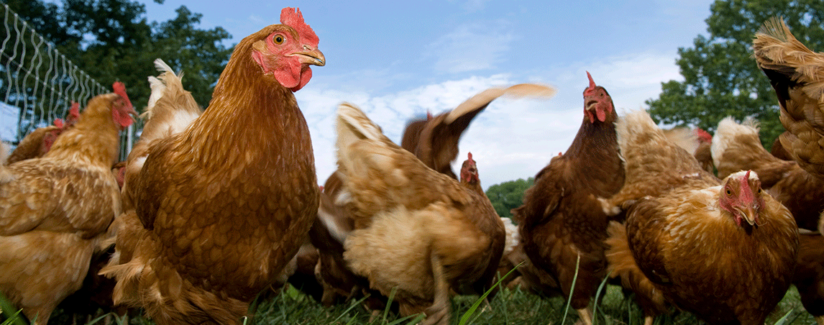
Farm-Raised Chickens: Answers on Antibiotics, Hormones and More
08/26/2016
Originally posted on December 21, 2015.
Consumers have a lot of questions about how chickens are raised these days. Are chickens fed additional hormones? How about antibiotics? And what does the label farm-raised chickens really mean?
Best Food Facts checked in with experts Dr. Ken Macklin, with the Department of Poultry Science, Auburn University and Dr. Terry Etherton, with the Department of Dairy & Animal Science at Penn State University for answers.
Are hormones given to chickens raised for meat? If not, what is the difference between chicken labeled as hormone-free and chicken that does not carry that label?
Dr. Macklin:
No chickens raised in the U.S. or internationally, are given hormones. Feeding chickens additional hormones has been illegal in the U.S. since the 1950s, and it’s just not a cost-effective way to raise chickens. Why do some companies label chicken as hormone-free? Chickens have hormones like all living things, but there are no additional hormones labeled to any chickens, anywhere. There is no difference between chickens labeled as hormone-free and those that do not carry that label.
Dr. Etherton:
Hormones are not used in poultry production for broilers or egg layers. Every animal and plant that exists has natural hormones that they produce. The only difference between chicken labeled hormone-free and chicken not labeled as such is how the company chooses to market the product.
What does the label farm-raised chicken mean? Aren’t all chickens raised on farms?
Dr. Etherton:
As far as I know it doesn’t have a specific definition. All chickens and animals raised for food production are raised on a farm of some sort, whether it’s large, small or in between.
Dr. Macklin:
They all are farm-raised. Some companies choose to market their products differently to appeal to their customer base. To be honest, every single chicken producer in the country could label their product as farm-raised in a literal sense.
Are farm-raised chickens raised with antibiotics?
Dr. Macklin:
The farm-raised chickens label really doesn’t differentiate, unless it says raised without antibiotics. They’ll all be antibiotic free because they went through a withdrawal period. The farm-raised label doesn’t mean they are raised without antibiotics.
Dr. Etherton:
There are some that are, but that is being phased out. Sub-therapeutic doses put in feed, primarily for broilers, to deal with sub-clinical health issues will be phased out.
Should I be concerned that eating chicken that was fed antibiotics might have antibiotic residue, or contribute to increased antibiotic resistance?
Dr. Etherton:
No, first, the dose is really, really small. Secondly, those antibiotics are typically not used in human health. Thirdly, if you just look at the population evidence, we’ve got people living longer than ever before and we’ve got the safest food supply in recorded history, and my view is that we shouldn’t be concerned.
Dr. Macklin:
Representatives from every flock are tested for antibiotic residue. That’s why they have the withdrawal period from seven to 14 days before the birds are processed, during which time the chickens are not given any antibiotics to make sure there is none in the meat. It’s a bit harder to say, whether antibiotic resistance is increasing. There are those that think livestock and poultry use of antibiotics contribute to antibiotic resistance, and there’s some compelling evidence that it may. On the flip side, there’s plenty of evidence to say that it doesn’t contribute to antibiotic resistance. As a scientist, I can’t say there is enough evidence to say that livestock and poultry use of antibiotics does or does not contribute to antibiotic resistance.
Will new regulations limiting the use of animal antibiotics important to human medicine affect how chickens are raised?
Dr. Macklin:
The new regulations will not affect companies with a veterinarian on staff at all. Even broiler companies that have a consulting vet shouldn’t see major disruptions because the new regulations require a veterinarian to write a prescription. It will reduce use of growth promotants, but it really won’t affect how chickens are raised. Chicken might cost a little more because they won’t grow as fast or as uniform, so production may not be as efficient.
Dr. Etherton:
Animals that periodically have sub-clinical health issues that affect growth rate can cause an economic problem. The industry will just have to deal with it. If, for example, feed efficiency worsens and it takes longer to grow animals to market weight, there will be an economic cost to consumers.
Will these new regulations mean chickens get sick more often?
Dr. Etherton:
I would expect that will be the case, but if it’s sub-clinical you might not see it, so it’s a fine gray line.
Dr. Macklin:
Yes, I know of a company that is completely antibiotic free, and they have a hard time combating illnesses. Veterinarians have a hard time not being able to treat animals when they get sick. Veterinarians take an oath to protect animal health and welfare, and they don’t like seeing these animals get sick. If the veterinarian works for a company producing antibiotic-free chicken, and they must treat a bird, it has to go to a different processing plant and is a logistical problem. If the chickens get sick more often, feed efficiency (amount of feed per lb. of gain) gets worse and the uniformity of the chicken suffers, it will be very challenging for producers.
Do I need to be concerned about eating chicken that might have been sick?
Dr. Macklin:
Assuming all safety procedures that are in place work properly, you will not be eating a sick chicken. There are a number of safeguards in place to prevent this. If the chickens are sick, they should not be sent from the farm to the processing plant. When the chickens get to the processing plant they are inspected by crews from the processing plant and USDA inspectors. While no process is 100 percent effective, I wouldn’t be too concerned about eating sick chicken, because there are a lot of safeguards in place. Also, you should inspect poultry you purchase at the grocery store and be sure to cook poultry to adequate temperatures. As long as you cook chicken properly it should be safe.
Dr. Etherton:
Animals that go into the food chain go through USDA-inspected plants, so there is a visual inspection of the carcass. With proper handling and cooking, food will be safe. For food safety, we have evolved the best system we’ve ever had, but even that system is not absent of risk.
Are there alternatives to antibiotics to keep chickens healthy?
Dr. Etherton:
I think best management practices and biosecurity methods, to attempt to keep out any pathogens, will be really important.
Dr. Macklin:
There are many alternatives. Pre-biotics feed the good bacteria and fight off the bad. Probiotics are your good bacteria, (similar to yogurt with the live cultures for humans) to fight off the bad bacteria. Then you have essential oils, organic acids and a whole slew of options producers can use to keep chickens healthy. The fault with many of them is they just are not as effective as antibiotics, which is why the poultry industry has used antibiotics for so long.
Is there a risk that the chicken I purchased from the grocery store may have been raised in the U.S., but processed in China?
Dr. Macklin:
There may be a risk but it is so miniscule, you shouldn’t worry about it. I would hazard a guess that 99.99 percent of chickens are raised and processed in the U.S. with 100 percent of chicken you find in the store being raised in the U.S. Also, any products shipped to the U.S. would have to meet our processing standards, meaning there are USDA inspectors on site watching the processors. The U.S. would not send live chickens – if anything, we would be sending carcasses to be further processed. Those steps are inspected by USDA, so steps are in place to make sure everything is up to our standards.
Dr. Etherton:
I’m not sure the economics would make sense to grow chickens in the U.S., ship them to China and have companies from China ship them back here, though traceability is a challenge in animal agriculture, so it’s hard to know definitively.



























